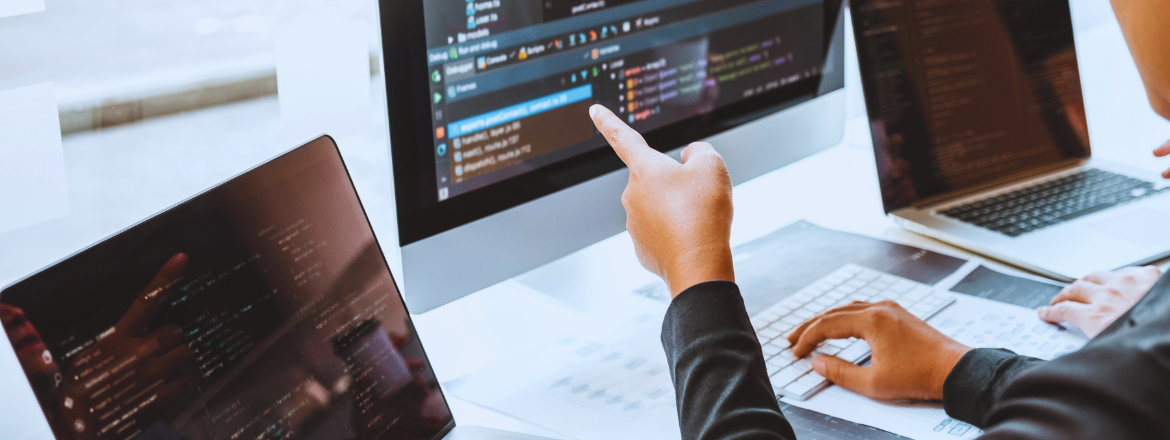Understanding How Procedural Abstraction Makes Code More Manageable – Definition
Procedural abstraction is a fundamental concept in computer science and software engineering, referring to the process of hiding implementation details of a procedure or function while exposing only its essential features or functionality. Built-in functions, called functions, and own functions defined by developers encapsulate algorithms or specific tasks and logic, playing a crucial role in this. Own functions allow for procedural abstraction by defining and using procedures or functions that abstract over a group of statements or expressions, facilitating the creation of modular and reusable code. This approach not only simplifies code interpretation but also enhances software design and maintainability by allowing developers to focus on the high-level logic of a program. It gives a name to a code block, thereby hiding the intricate details of its implementation and promoting good software design and maintainability. By examining the following example, we can see how procedural abstraction simplifies code interpretation and enhances readability.
Importance of Procedural Abstraction in Software Development
Procedural abstraction plays a crucial role in software development by promoting modularity, code reusability, and maintainability. By enclosing complex operations within well-defined procedures or functions, developers can break down large systems into smaller, more manageable components, making the codebase easier to understand, debug, and maintain. Additionally, procedural abstraction eliminates the need for extensive documentation by containing complexity, further simplifying the development process.
Overview of Procedural Abstraction in the Context of Intellectual Property
In the realm of intellectual property, procedural abstraction extends beyond software development to encompass the legal framework governing the protection of intangible assets such as patents, trademarks, copyrights, and trade secrets. It involves abstracting complex legal concepts and procedures into standardized frameworks and processes that facilitate the identification, registration, enforcement, and defense of intellectual property rights. This abstraction enables stakeholders to navigate the complexities of IP law more efficiently and effectively, thereby safeguarding their innovations, creations, and commercial interests. Moreover, procedural abstraction prevents programmers from accidentally using the intellectual property of other programmers, further safeguarding against the misuse of such assets.
Introduction to Intellectual Property (IP) Rights
Intellectual property comprises the fruits of intellectual creativity, encompassing inventions, literary and artistic creations, symbols, trademarks, and designs employed in commercial ventures. ntellectual property rights afford creators exclusive privileges to their creations, empowering them to derive financial benefits and exercise control over their utilization.
Common types of IP rights include patents, trademarks, copyrights, and trade secrets. Additionally, IP rights play a crucial role in protecting the creators of computer programs, ensuring they can secure and monetize their innovations in the digital economy.
Types of Intellectual Property
Patents: Patents serve to safeguard inventions or discoveries by providing the inventor with exclusive rights to produce, utilize, and distribute the innovation for a designated period, typically spanning 20 years.
Trademarks: Trademarks safeguard distinct signs, symbols, or logos utilized to differentiate and identify goods or services from those offered by competitors.
Copyrights: Copyrights protect original works of authorship, such as literary, artistic, musical, and dramatic works, as well as software code, granting authors exclusive rights to reproduce, distribute, and publicly perform or display their works.
Trade Secrets: Trade secrets safeguard proprietary information that confers a competitive edge, encompassing formulas, methodologies, procedures, or client rosters, provided they are maintained as confidential.
Importance of Protecting Intellectual Property in Today's Digital Economy
In today's knowledge-based economy, intellectual property plays a critical role in driving innovation, fostering creativity, and promoting economic growth. IP protection incentivizes investment in research and development, encourages entrepreneurship, and facilitates the commercialization of new ideas and technologies. Without adequate IP protection, creators and innovators may be discouraged from investing time, effort, and resources into developing new products, services, or technologies, ultimately stifling innovation and hindering economic progress. Therefore, safeguarding intellectual property rights is essential for promoting innovation, competitiveness, and sustainable development in the digital age.
Overview of Procedural Aspects of Intellectual Property Law
Intellectual property law encompasses a wide range of legal principles, rules, and procedures governing the creation, registration, enforcement, and protection of intellectual property rights. Procedural aspects of IP law include the processes and mechanisms for obtaining, maintaining, and defending IP rights, as well as the resolution of disputes and infringement claims.
Role of Procedural Rules and Regulations in IP Protection
Procedural rules and regulations play a crucial role in ensuring the effective administration and enforcement of intellectual property rights. These rules govern various aspects of the IP lifecycle, including the filing and examination of patent applications, the registration and maintenance of trademarks and copyrights, and the handling of infringement disputes and litigation. By establishing clear procedures and standards, IP laws provide a framework for resolving conflicts, protecting the interests of rights holders, and promoting innovation and creativity.
How Procedural Abstraction Applies to IP Law
Procedural abstraction in the context of intellectual property law involves simplifying and standardizing complex legal processes and concepts into abstract models or frameworks that facilitate their application and implementation. This abstraction enables stakeholders, including inventors, creators, businesses, and legal professionals, to navigate the intricacies and parameters of IP law more efficiently and effectively. By abstracting procedural elements such as application procedures, examination criteria, enforcement mechanisms, and dispute resolution processes, IP laws provide clarity, predictability, and consistency, thereby promoting certainty and confidence in the IP system. Additionally, procedural abstraction facilitates interoperability and harmonization of IP laws across different jurisdictions, fostering international cooperation and trade in intellectual property.


Challenges and Considerations
Common Challenges in Applying Procedural Abstraction to IP Code
Despite its benefits, applying procedural abstraction to intellectual property law can pose several challenges. One common challenge is the complexity and variability of IP laws and regulations across different jurisdictions. The interpretation and application of procedural rules may vary significantly from one country to another, leading to inconsistencies and uncertainties for rights holders and applicants. Additionally, the rapid pace of technological advancements and the evolving nature of IP rights present ongoing challenges in adapting procedural frameworks to address emerging issues and trends.
Impact of Technological Advancements on Procedural Abstraction in IP Law
Technological advancements, particularly in areas such as artificial intelligence, blockchain, and biotechnology, are reshaping the landscape of intellectual property law and challenging traditional procedural frameworks. For example, the rise of digital technologies and online platforms has raised questions about the applicability of existing IP laws to digital content, data values, and virtual assets. Similarly, the proliferation of blockchain technology has introduced new challenges and opportunities for IP protection, such as the authentication and enforcement of digital rights.
Case Studies or Examples Illustrating Procedural Abstraction in IP Litigation
Examining real-world case studies or examples can provide valuable insights into the application of procedural abstraction in intellectual property litigation. For instance, landmark court cases involving patent disputes, trademark infringement, copyright infringement, or trade secret misappropriation can highlight the role of procedural rules and mechanisms in resolving IP conflicts. By analyzing how procedural abstraction is used to streamline legal processes, protect rights holders, and promote fair and efficient resolution of disputes, stakeholders can gain a better understanding of the complexities and nuances of IP law in practice.
Best Practices for IP Protection
Strategies for Effectively Leveraging Procedural Abstraction
Implementing effective strategies for leveraging procedural abstraction can enhance IP protection efforts and streamline legal processes. One key strategy is to develop standardized procedures and workflows for managing intellectual property assets, including filing, prosecution, maintenance, and enforcement activities. By establishing clear guidelines and protocols, organizations can ensure consistency, efficiency, and compliance with legal requirements throughout the IP lifecycle.
Importance of Staying Updated on Procedural Developments in IP Law
Intellectual property laws and procedural rules are constantly evolving in response to technological advancements, legislative changes, and judicial interpretations. To stay ahead of the curve, it is essential for stakeholders to stay updated on the latest developments and trends in IP law. This includes monitoring changes in legislation, court decisions, and regulatory guidance, as well as participating in industry forums, conferences, and professional networks. By staying informed and proactive, organizations can anticipate potential challenges, capitalize on emerging opportunities, and adapt their IP strategies accordingly.
Collaboration Between Legal and Technical Teams
Collaboration between legal and technical teams is essential for effective IP protection. Legal professionals play a crucial role in navigating the complexities of IP law, interpreting written procedural rules, and representing the interests of rights holders in legal proceedings. Meanwhile, technical experts, such as engineers, scientists, and inventors, provide valuable insights into the technical aspects of intellectual property, including patentable inventions, trademark designs, and copyrighted works. By fostering collaboration and communication between legal and technical teams, organizations can develop holistic IP strategies that align with business objectives, mitigate risks, and maximize the value of their intellectual property portfolios and related assets.
Future Trends and Implications
Emerging Trends in Procedural Abstraction
As technology continues to advance and reshape the intellectual property landscape, several emerging trends are shaping the future of procedural abstraction. One such trend is the increasing use of automation and artificial intelligence (AI) in IP law, including the automation of patent searches, trademark examinations, and copyright registrations. AI-powered tools and algorithms have the potential to streamline procedural processes, reduce administrative burdens, and improve decision-making accuracy in IP proceedings.
Potential Implications of Procedural Abstraction for Innovation and Creativity
Procedural abstraction has the potential to impact innovation and creativity by influencing the accessibility, affordability, and effectiveness of intellectual property protection. By simplifying procedural processes and reducing administrative barriers, procedural abstraction can encourage greater participation in the innovation ecosystem, particularly among startups, small businesses, and individual inventors. However, it is essential to strike a balance between promoting access to intellectual property rights and safeguarding against abuse or misuse of the system to ensure fair and equitable outcomes for all stakeholders.
How Advancements in Technology and Globalization May Shape the Future of IP Protection
Advancements in technology, coupled with increasing globalization, are reshaping the landscape of intellectual property protection and enforcement. The rise of digital technologies, e-commerce platforms, and online marketplaces has led to new challenges and opportunities for IP rights holders, such as combating online counterfeiting, piracy, and infringement. Additionally, the growing interconnectedness of global markets and supply chains has underscored the importance of international cooperation and harmonization of IP laws to address cross-border IP issues effectively. As such, the future of IP protection will likely be shaped by ongoing technological innovations, regulatory developments, and international collaborations aimed at fostering innovation, promoting creativity, and protecting intellectual property rights in the digital age.
Conclusion
As the digital economy continues to evolve and the pace of innovation accelerates, it is more important than ever for businesses and individuals to prioritize intellectual property protection strategies. By leveraging procedural abstraction, staying updated on procedural developments, and fostering collaboration between legal and technical teams, organizations can effectively navigate the challenges and opportunities presented by the evolving IP landscape.
In conclusion, procedural abstraction offers a powerful framework for managing intellectual property rights and addressing the complex legal issues surrounding innovation and creativity. By embracing procedural abstraction and adopting best practices for IP protection, businesses and individuals can position themselves for success in an increasingly competitive and dynamic marketplace.






